Lithium-ion Battery Market Size, Share, Statistics and Industry Growth Analysis Report by Type (NMC, LFP, LCO, LTO, LMO, NCA), Capacity (Below 3,000 mAh, 3,001 mAh–10,000 mAh, 10,001 mAh–60,000 mAh, Above 60,000 mAh), Voltage (Below 12V, 12V–36V, Above 36V), Application and Region - Global Forecast to 2032
[267 Pages Report] The global lithium-ion battery market size is expected to grow from USD 56.8 billion in 2023 to USD 187.1 billion by 2032, at a CAGR of 14.2% from 2023 to 2032. The global demand for batteries, especially lithium-ion batteries, is mainly driven by electrification of mobility, energy transition at the grid level, and largely to reduce the impact of climate change by fossil fuels. Additionally, the growing adoption and popularity of hybrid and electric vehicles across countries is one of the key drivers for the growing demand for lithium-ion batteries. Continuous research & development of new and improved battery technologies, such as lithium-sulfur batteries, lithium-silicon batteries, etc., are expected to offer opportunities for the lithium-ion battery market. Further, battery manufacturers are increasingly focusing on environmentally friendly sourcing and manufacturing practices to make the battery industry sustainable and circular, which is expected to result in sustainable market growth.
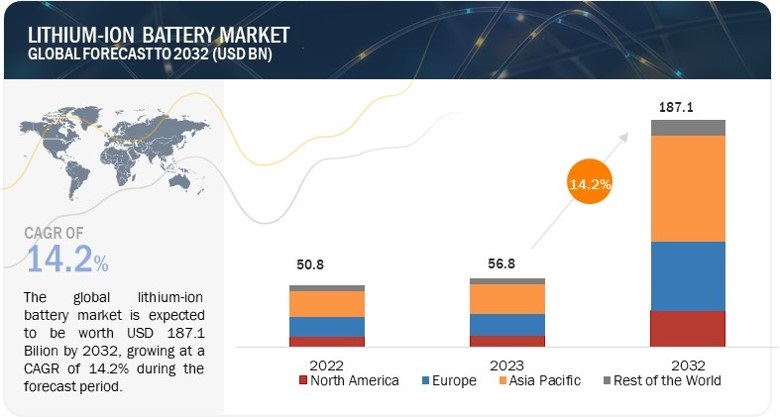
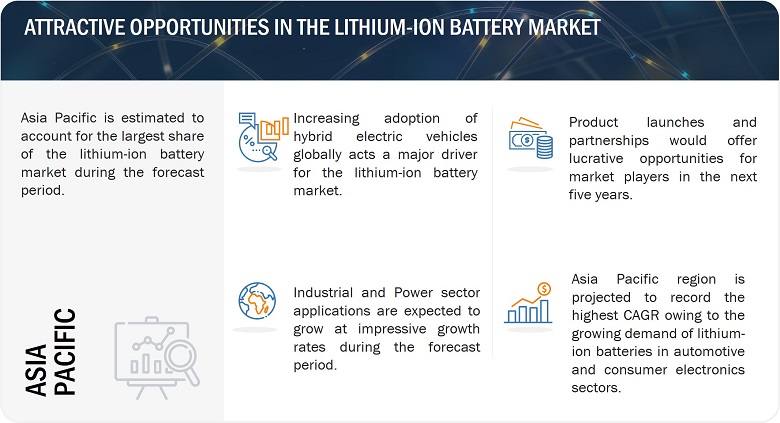
Lithium-ion Battery Market Forecast to 2032
To know about the assumptions considered for the study, Request for Free Sample Report
Market Dynamics
DRIVERS: Growing demand for battery-operated material-handling equipment across industries
Due to the increase in industrial automation, material-handling equipment has also evolved to support the changing requirements of various industries. With time, various technological advancements have occurred in the material-handling equipment industry. Automated material handling and lifting equipment, including automated guided vehicles, elevating equipment, industrial trucks, and intralogistics systems, have undergone various technological advancements that require batteries. Lithium-ion batteries are being adopted significantly for use in various material-handling equipment such as forklifts, robots, ground support equipment, etc.
RESTRAINTS: Concerns regarding handling of used batteries
Used lithium-ion batteries from hybrid electric vehicles, smartphones, laptops, watches, etc., are accumulating because cost-effective solutions for recycling these batteries are unavailable. As spent/used batteries hold a residual charge, there lies the risk of unplanned discharge, which may cause harm to properties and people. Large lithium-based batteries, such as those used for automotive applications, can be mistaken for other types of batteries such as lead-acid, if inappropriately labeled by local battery manufacturers. If not sorted correctly, these could pose a danger and must be separated from spent lead-acid batteries before storage.
OPPORTUNITIES: Growing integration of renewable energy integration in power grids globally
In recent years, energy generation has significantly changed from fossil fuels to renewable energy sources such as solar, wind, and water. Various economies are taking initiatives to switch to cleaner energy sources. For instance, the European Union is rapidly accelerating the implementation of solar photovoltaic (PV) and wind initiatives in response to a possible energy crisis in the coming future. In 2022, the region witnessed a remarkable addition of over 50 GW of renewable energy in new capacity, signifying an impressive 45% increase compared to the previous year. The introduction of ambitious policies and targets outlined in the REPowerEU Plan and The Green Deal Industrial Plan are expected to be significant catalysts for attracting substantial investments in renewable energy projects throughout the European Union in the coming years.
CHALLENGES: Performance degradation in lithium-ion batteries overtime
Performance degradation of the lithium-ion battery over the lifecycle is unavoidable. Despite remarkable recent developments and enhancements in battery technologies, lithium-ion cells age with time and usage, reducing their energy and storage capabilities. Battery cell deterioration is noticeable in mobile phones and laptops. Lithium-ion batteries age over time due to chemical and physical processes that occur during charging, discharging, and storage. These processes include chemical reactions between the electrodes, dendrite formation, lithium plating, thermal stress, calendar aging, cycle aging, and self-discharge. These factors contribute to a gradual decline in the battery's capacity and overall performance.
Lithium-Ion Battery Market Ecosystem
Prominent companies in this market include well-established, financially stable manufacturers such as LG Energy Solution (South Korea), Samsung SDI Co. Ltd. (South Korea), SK Innovation Co., Ltd. (South Korea), Panasonic Holdings Corporation (Japan), BYD Company Limited (China), and Toshiba Corporation (Japan). These companies have been operating in the market for several years and possess a diversified product portfolio, state-of-the-art technologies, and strong global sales and marketing networks. Along with the well-established companies, there are a large number of startups and small companies operating in this market, such as Lithium Werks (The Netherlands), Sila Nanotechnologies, Inc. (US), Northvolt AB (Sweden).
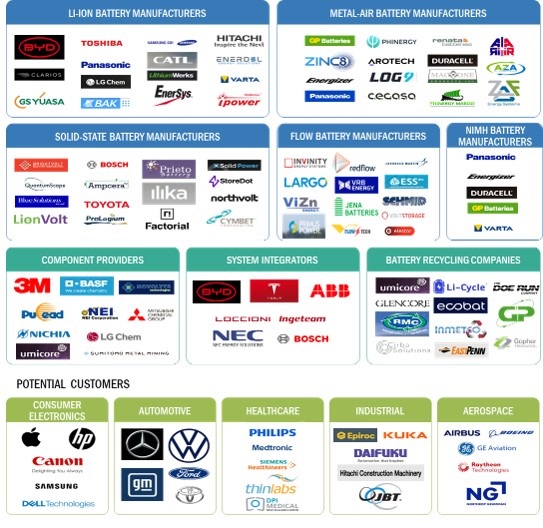
Lithium Nickel Manganese Cobalt (NMC) batteries segment is expected to grow at the substantial growth rate during the forecast period.
An NMC battery is a combination of lithium with materials such as nickel-manganese-cobalt. It can be used as an energy cell or power cell. Like other lithium-ion battery varieties, NMC batteries can have either high specific energy density or high specific power. The effectiveness of NMC depends upon the combination of nickel and manganese. Separately, both are not very effective, but combining these two elements enhances their strengths and helps overcome their drawbacks. This battery type is preferred in automotive applications due to its very low self-heating rate. It is also used in power tools, medical equipment, and industrial equipment.
The market for above 60,000 mAh is projected to gain significant market share during the forecast period
These high-capacity batteries are used as power backup and for powering heavy electric vehicles, industrial applications, hybrid electric vehicles, electric boats, energy storage systems, and emergency power systems. They are also utilized in uninterrupted power supply, inverters, telecommunications, power, manufacturing, etc. These applications have unique power requirements. Hence, lithium-ion batteries are preferred in these high-power applications as they offer advantages such as overcharge protection, high and low temperature protection, and short circuit protection. They cannot be made from single cells and, hence, require modules and sometimes an array of modules, power racks, and power containers.
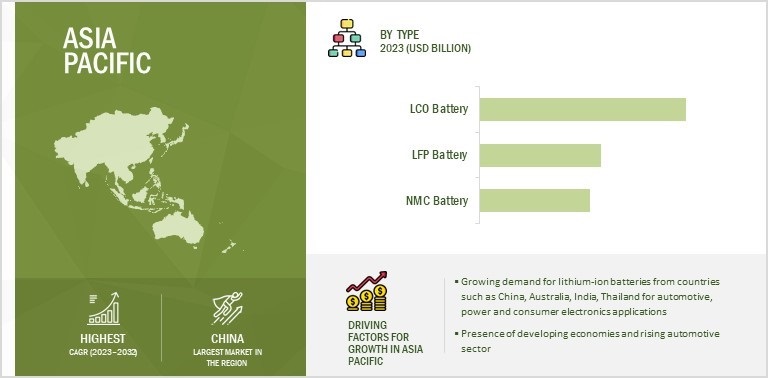
Lithium-ion Battery Market Statistics by Region
To know about the assumptions considered for the study, download the pdf brochure
The market in Asia Pacific is projected to grow at the highest CAGR from 2023 to 2032.
The market in Asia Pacific has been segmented into China, Japan, India, Australia, Indonesia, Thailand, and the Rest of Asia Pacific. The region is the prime manufacturer and consumer of lithium-ion batteries. Asia Pacific is witnessing a huge demand for lithium-ion batteries from leading consumer electronics manufacturers in the region. Advancements in the technologies used in wearable devices and consumer electronics in Asia Pacific are also fueling the Lithium-ion Battery Market Growth in the region.
China accounted for the largest share of the lithium-ion battery market in Asia Pacific as it is one of the major lithium-ion battery producers in the region. Increasing R&D for the development of new battery technologies by various countries in Asia Pacific is another factor driving the growth of the lithium-ion battery market in the region.
Key Market Players
LG Energy Solution (South Korea), SK Innovation Co., Ltd. (South Korea), Panasonic Holdings Corporation (Japan), BYD Company Limited (China), Samsung SDI Co. Ltd. (South Korea), and Toshiba Corporation (Japan) are among a few top players in lithium-ion battery companies.
Lithium-ion Battery Market Report Scope
|
Report Metric |
Details |
|
Estimated Market Size in 2023 |
USD 56.8 Billion |
|
Projected Market Size in 2032 |
USD 187.1 Billion |
|
Growth Rate |
CAGR of 14.2% |
|
Market size available for years |
2019—2032 |
|
Base year |
2022 |
|
Forecast period |
2023—2032 |
|
Forecast Units |
USD Millions/USD Billions and Million Units |
|
Segments Covered |
Material, Product type, Type, Capacity, Voltage, and Application |
|
Geographic regions covered |
North America, Europe, Asia Pacific, and RoW |
|
Companies covered |
BYD Company Limited (China), Panasonic Holdings Corporation (Japan), Samsung SDI Co. Ltd. (South Korea), GS Yuasa Corporation (Japan), Toshiba Corporation (Japan), Hitachi, Ltd. (Japan), LG Energy Solution (South Korea), SK Innovation Co., Ltd. (South Korea) and Others- (Total 26 players have been covered) |
Lithium-ion Battery Market Highlights
This research report categorizes the lithium-ion battery market by material, product type, type, capacity, voltage, application, and region.
|
Segment |
Subsegment |
|
By Material: |
|
|
By Product Type: |
|
|
By Type: |
|
|
By Capacity: |
|
|
By Voltage: |
|
|
By Application: |
|
|
By Region |
|
Recent Developments
- 21st Oct 2023, Japanese researchers have developed lithium-ion batteries that don't rely on cobalt, a costly and resource-constrained material commonly found in commercial lithium-ion batteries. Their innovative approach uses a combination of elements in the electrodes, including lithium, nickel, manganese, silicon, and oxygen, resulting in batteries that are 60% more energy-dense and more powerful, with a voltage of 4.4 volts. The experimental batteries also demonstrated good longevity, retaining 80% of their capacity after over 1,000 charging and discharging cycles. This breakthrough has the potential to improve the environmental, economic, and social aspects of battery production.
- In May 2023, GS Yuasa Corporation and Honda Motor Co., Ltd. signed a joint venture (JV) to form a new company called Honda GS Yuasa EV Battery R&D Co., Ltd. This JV company will focus on researching and developing lithium-ion batteries and battery manufacturing techniques to fulfill the growing demand for EV batteries.
- 5th Oct 2023, Researchers have discovered a method to use manganese, a more abundant mineral, to create cost-effective, high-performance lithium-ion (Li-ion) batteries, offering an alternative to the limited nickel and cobalt resources used in battery production. These synthesized manganese-based materials, featuring a unique nanostructure, exhibit the high stability and energy density required for Li-ion batteries. This innovation is crucial for addressing resource challenges in battery production and lowering costs while reducing dependence on scarce metals like nickel and cobalt, potentially meeting future energy demands.
- 2nd Oct 2023, Recycling lithium-ion batteries is essential for the environmental sustainability of India's growing electric vehicle (EV) industry. BatX Energies, a company founded in 2020, reclaims and recycles vital Earth metals from discarded lithium-ion cells, including lithium, cobalt, nickel, and manganese, which are crucial for battery production. By adopting a 'Hub and Spoke' strategy in collaboration with OEMs and channel partners, they streamline the collection process and ensure compliance with regulations. Recycling helps reduce the environmental impact and dependency on imports for rare earth materials in lithium-ion cell manufacturing while creating job opportunities and skilled workforces in electronic waste management. The recycled materials are reintroduced into the supply chain and used in various industries, promoting a circular economy for lithium-ion battery manufacturing. BatX Energies plans to expand its operations globally, addressing similar challenges in other markets like South Africa, the USA, and Europe.
- 18th Sept 2023, Gotion, a lithium-ion battery manufacturer, is investing $2 billion in its first North America-based factory in Manteno, Illinois. The facility, set to become the largest EV battery production investment in the state, will reuse an existing Kmart distribution center, employing up to 2,600 workers. The plant will produce 40 GWh lithium-ion battery cells and 10 GWh battery packs, focusing on energy storage system integration and supporting Illinois' climate change goals. Gotion will receive significant state incentives and plans to build a battery component factory in Michigan.
- 6th Sept 2023, Ascend Elements, a manufacturer of sustainable battery materials for electric vehicles, has secured $542 million in equity investments. They are building North America's first sustainable cathode precursor (pCAM) and cathode active material (CAM) manufacturing facility. The technology uses used lithium-ion battery materials and gigafactory manufacturing scrap to create sustainable materials, reducing carbon emissions by up to 93%. This investment will advance the construction of the Apex 1 facility in Kentucky, producing enough sustainable pCAM for 750,000 electric vehicles per year and supporting the global transition to zero carbon emissions.
- 5th Spet 2023, The BMZ Group, a prominent lithium-ion battery manufacturer, has acquired Nox Cycles Austria, along with its sister companies in Germany and Switzerland, as well as the Hawk Bikes brand. This acquisition strengthens BMZ's position in the e-bike industry, with a particular focus on 'Made in Austria' production. Both companies emphasize continuity in management, customer relationships, and employees, aiming to enhance innovation and expand production and sales under the new partnership.
Frequently Asked Questions (FAQs)
What is the total CAGR expected to be recorded for the lithium-ion battery market during 2023-2032?
The global lithium-ion battery market is expected to record a CAGR of 14.2% from 2023–2032.
What are the driving factors for the lithium-ion battery market?
Accelerating adoption of hybrid electric vehicles and the rapidly evolving consumer electronics sector are some of the driving factors for the lithium-ion battery market.
Which application will grow at a fast rate in the future?
The power application is expected to grow at the highest CAGR during the forecast period. The need to fulfill requirements for peak electricity demand is the major factor contributing to the segment's growth.
Which are the significant players operating in the lithium-ion battery market?
LG Energy Solution (South Korea), Samsung SDI Co. Ltd. (South Korea), SK Innovation Co., Ltd. (South Korea), Panasonic Holdings Corporation (Japan), BYD Company Limited (China), and Toshiba Corporation (Japan) are among a few top players in the lithium-ion battery market.
Which region will grow at a fast rate in the future?
The lithium-ion battery market in Asia Pacific is expected to grow at the highest CAGR during the forecast perio.
To speak to our analyst for a discussion on the above findings, click Speak to Analyst
The study involved four major activities in estimating the current size of the lithium-ion battery market. Exhaustive secondary research has been done to collect information on the market, peer, and parent markets. The next step has been to validate these findings, assumptions, and sizing with industry experts across the value chain through primary research. Both top-down and bottom-up approaches have been employed to estimate the total market size. After that, market breakdown and data triangulation methods were used to estimate the market size of segments and subsegments. Two sources of information—secondary and primary—have been used to identify and collect information for an extensive technical and commercial study of the lithium-ion battery market.
Secondary Research
Secondary sources include company websites, magazines, industry news, associations, and databases (Factiva and Bloomberg). These secondary sources include annual reports, press releases, investor presentations of companies, white papers, certified publications, articles by recognized authors, regulatory bodies, trade directories, and databases.
Primary Research
Primary sources mainly consist of several experts from the core and related industries, along with preferred lithium-ion battery providers, distributors, alliances, standards, and certification organizations related to various segments of this industry’s value chain.
In the primary research process, various primary sources from both supply and demand sides were interviewed to obtain qualitative and quantitative information on the market. The primary sources from the supply side included various industry experts such as Chief Experience Officers (CXOs), Vice Presidents (VPs), and Directors from business development, marketing, product development/innovation teams, and related key executives from lithium-ion battery providers, such as LG Energy Solution (South Korea). Samsung SDI Co. Ltd. (South Korea), and Panasonic Holdings Corporation (Japan); research organizations, distributors, industry associations, and key opinion leaders. Following is the breakdown of primary respondents.
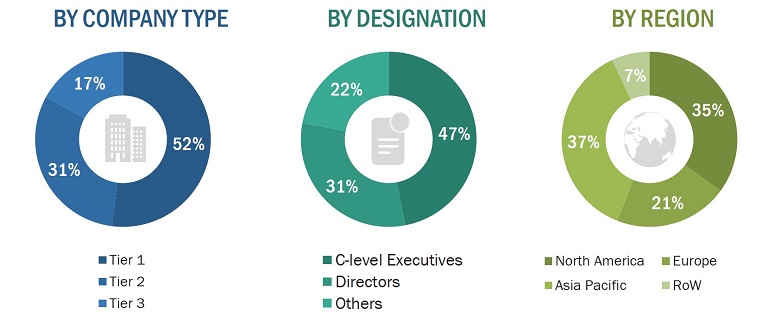
To know about the assumptions considered for the study, download the pdf brochure
Market Size Estimation
Both top-down and bottom-up approaches have been used to estimate and validate the total size of the lithium-ion battery market. These methods have also been used extensively to estimate the size of various subsegments in the market. The following research methodology has been used to estimate the market size:
- Major players in the industry and markets have been identified through extensive secondary research.
- The industry’s value chain and market size (in terms of value) have been determined through primary and secondary research processes.
- All percentage shares, splits, and breakdowns have been determined using secondary sources and verified through primary sources.
Data Triangulation
After arriving at the overall market size from the estimation process explained above, the overall market has been split into several segments and subsegments. The market breakdown and data triangulation procedures have been employed, wherever applicable, to complete the overall market engineering process and arrive at the exact statistics for all segments and subsegments. The data has been triangulated by studying various factors and trends from both the demand and supply sides. The market has also been validated using both top-down and bottom-up approaches.
Top-Down Approach
In the top-down approach, the overall market size has been used to estimate the size of the individual market segments (mentioned in market segmentation) through percentage splits from secondary and primary research. For specific market segments, the size of the most appropriate immediate parent market has been used to implement the top-down approach. The bottom-up approach has also been implemented for data obtained from secondary research to validate the market size of various segments.
Lithium-ion Battery Market: Top-down Approach

Bottom-Up Approach
The bottom-up approach has been used to arrive at the overall size of the lithium-ion battery market from the revenues of the key players and their market shares. Calculations based on revenues of key companies identified in the market led to the estimation of their overall market size.
Lithium-ion Battery Market: Bottom-up Approach

Market Definition
Lithium-ion battery is a rechargeable battery comprising lithium and various other materials, such as nickel, cobalt, and manganese. It is made up of three major components: cathode, anode, and electrolyte. In a lithium-ion battery, the lithium ions flow from the negative electrode to the positive electrode during discharge and in reverse while charging. Lithium-ion batteries are available in multiple variants, depending upon the materials that are combined with lithium such as cobalt, nickel, manganese, titanium, and iron. Consumer electronics, automotive, aerospace & defense, marine, medical, and power are some of the key application areas of lithium-ion batteries.
Key Stakeholders
- Lithium-ion battery manufacturers
- Government Bodies and Policymakers
- Industry-standard Organizations, Forums, Alliances, and Associations
- Market Research and Consulting Firms
- Raw Material Suppliers and Distributors
- Research Institutes and Organizations
- Testing, Inspection, and Certification Providers
- Distributors and Resellers
- End Users
Report Objectives
- To define and forecast the lithium-ion battery market regarding type, voltage, capacity, and application.
- To describe and forecast the lithium-ion battery market and its value segments for four regions—North America, Europe, Asia Pacific, and the Rest of the World (RoW), along with their respective countries.
- To provide detailed information regarding the drivers, restraints, opportunities, and challenges influencing the growth of the market
- To strategically analyze micro-markets concerning individual growth trends, prospects, and contributions to the overall market
- To study the complete value chain of the lithium-ion battery market
- To analyze opportunities in the market for stakeholders by identifying high-growth segments of the market
- To strategically profile key players and comprehensively analyze their market position regarding ranking and core competencies, along with a detailed market competitive landscape.
- To analyze strategic approaches such as agreements, collaborations, and partnerships in the lithium-ion battery market
- To provide an analysis of the recession impact on the growth of the market and its segments
Available Customizations:
Based on the given market data, MarketsandMarkets offers customizations in the reports according to the client’s specific requirements. The available customization options are as follows:
Company Information
- Detailed analysis and profiling of additional market players (up to 5)



 Generating Response ...
Generating Response ...







Growth opportunities and latent adjacency in Lithium-ion Battery Market
I would like to have a general idea about the future of Lithium-Ion Battery Market size on a global scale and in Austria specifically.